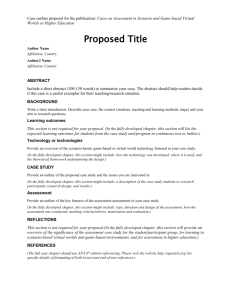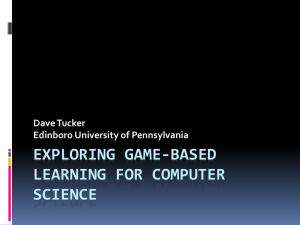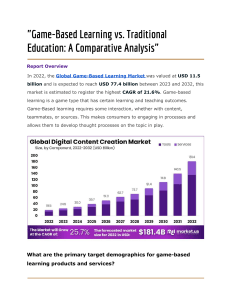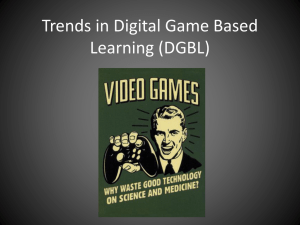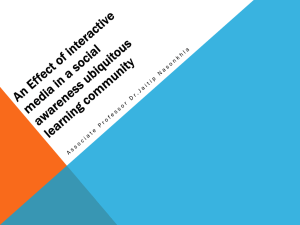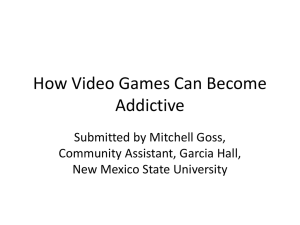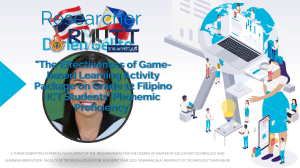Digital Game-Based Learning
advertisement
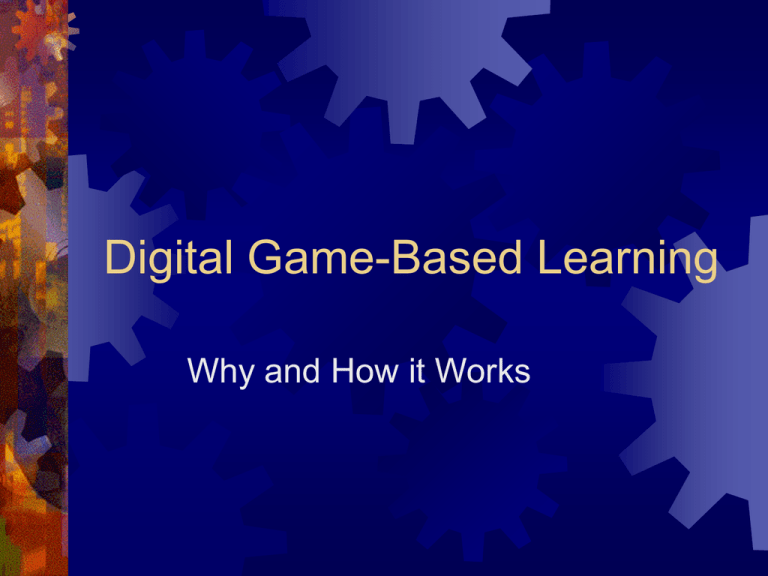
Digital Game-Based Learning Why and How it Works What is it? Why does it work? Most simply put, Digital Game-Based Learning is any marriage of educational content and computer games. So let us define Digital Game-Based Learning as any learning game on a computer or online. It should feel just like a video game or computer game all the way through. Why Digital Game-Based Learning Work? Engagement – That comes from putting the learning into a game context. Interactive learning process employed The way that the two are put together. Opportunities for success lead to a sense of purpose; that curiosity appeal leads to fascination; that simulated danger leads to stimulation and that social reinforcement leads to a sense of competence. Initiate > Persist > Succeed A cycle of initiate > persist > succeed leads players of training games to remain involved as they initiate game play, adopt a role, control game play, practice skills, solve problems persist to the end and strive to win (which translates as “learn”) Isn’t it hard to create Gamebased learning? You can start small and grow The people who have done it have really enjoyed the process and been successful. It’s getting easier all the time It’s definitely worth the effort How Do You Combine Computer Games and Learning? The best way depends on: The audience The subject matter The business and political context The technology available The resources and experience the can be brought to bear How you plan to get it out there What Makes Computer Games Fun? Challenge – Does the activity have a clear goal? Does it have a variable difficulty level? Does the program include hidden information selectively revealed? Fantasy – Does the program include an emotionally appealing fantasy? Is the fantasy related to the skill learned? Curiosity – Are there auditory and visual effects to stimulate sensory curiosity? Are the elements to stimulate cognitive curiosity like surprises and rewards? Variables that make a Difference – Seek a “lowest common denominator” that appeals to both older and younger audiences. Gender Competitiveness Previous Game Experience Use “Focus Groups” to get player input and preferences. Age Types of Learning Learn by Doing Doing is something that computer games are especially good at – they allow us to interact with them. What is critical is active participation by the learner. Types of Learning Learning from Mistakes Designing feedback to be less learninglike and more game-like is often a big paradigm shift and challenge for Digital Game-Based Learning designers. The best way to do this is to play a lot of games. Types of Learning Goal-Oriented Learning “It’s not what you know that’s important, it’s what you know how to do.” A goal is a key element of games – it’s what turns play into a game. The goals in a game, which are usually considered worth reaching are what gives the player the incentive to push on through repeated failure. Guided Discovery Learning Discovery learning is based on the idea that you learn something better if you find it out for yourself, rather than have it told to you. Discovery learning is what many games, and certainly all adventure games are all about. You come to a place, or a thing, or an enemy and you don’t know what it does or how to get past it, so you experiment, until you find the solution. Sometimes it’s best to guide the user a bit. Situated Learning This is an approach where the learning is set in an environment that is similar or identical to where the learning material will be applied in the future. Creating highly realistic and and immersive environments is something that games do particularly well. Role Playing Role playing is often used as a learning strategy in interactive training, Role playing is so much a part of games that it has it’s own genre –RPGs. One difference between role playing in interactive training is that training role playing tends to be much shorter and more structured. Coaching Coaching has been a part of games for a long time, often coming from various characters in the game that you happen across as you are exploring. Game designers often design “practice missions” to coach players through complicated skills. Constructivist Learning Constructivists believe that a person learns best when he or she is actively “constructs” ideas and relationships in their own minds based on experiments that they do, rather than being told. They also believe that people lean most effectively when they are engaged in constructing personally meaningful physical artifacts.
